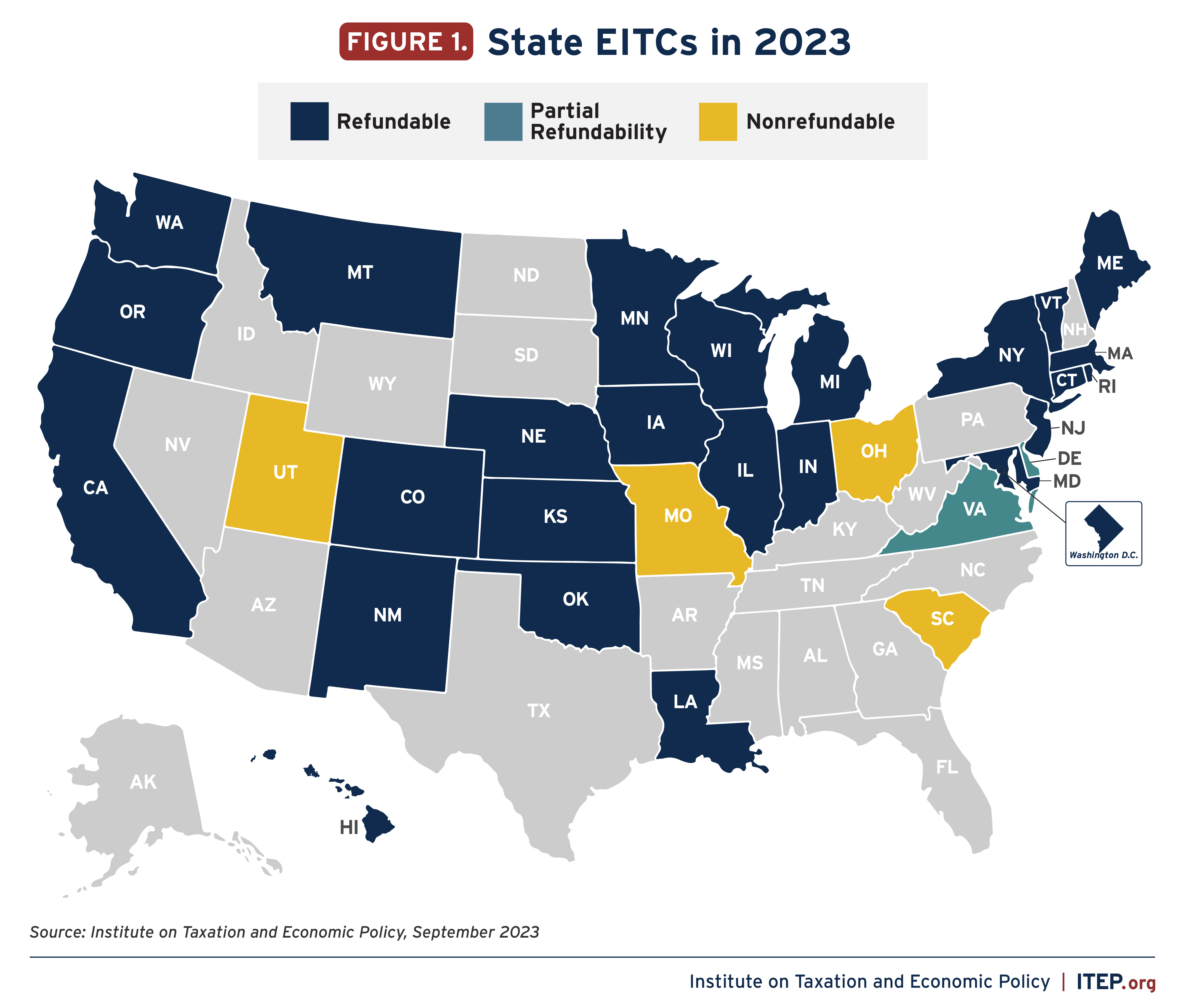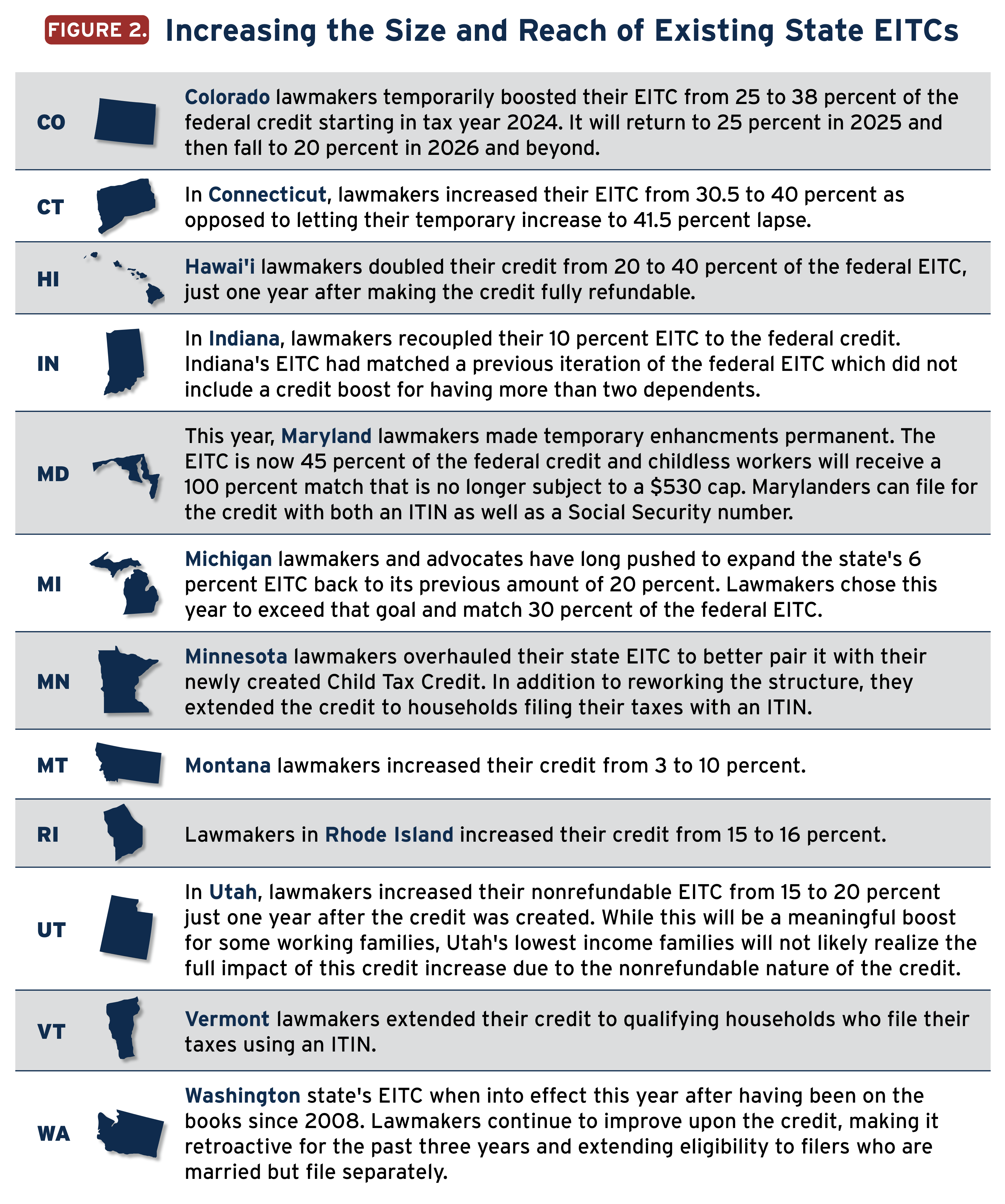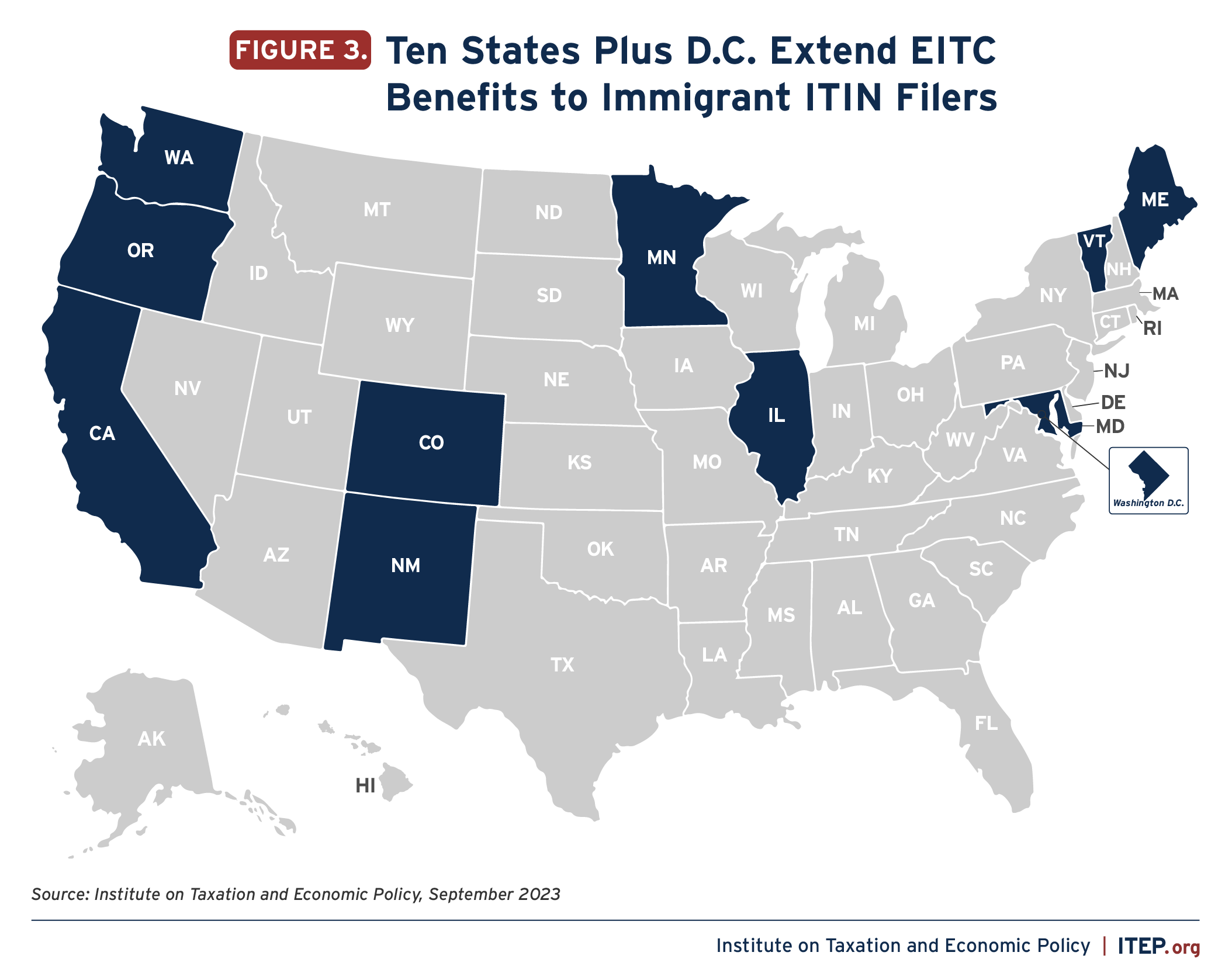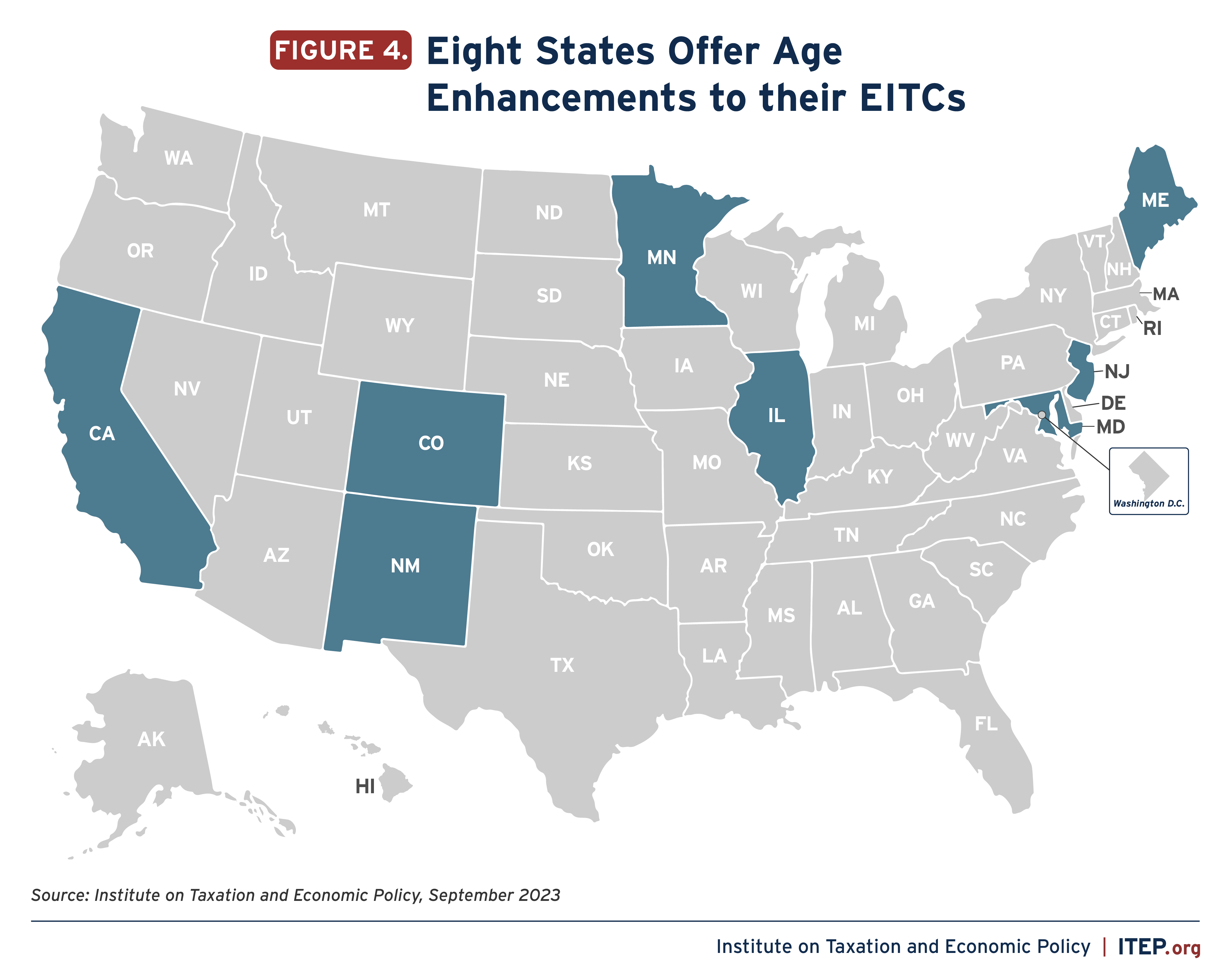Update (October 2023): Massachusetts Gov. Maura Healey signed an EITC increase into law. The legislation will increase the state’s credit from 30 to 40 percent of the federal credit. This is not included in the numerical counts in this brief.
Key findings
- Nearly two-thirds of states (31 plus the District of Columbia and Puerto Rico) have an Earned Income Tax Credit. These credits boost low-paid workers’ incomes and offset some of the taxes they pay, helping lower-income families achieve greater economic security.
- These state credits are usually built on the federal EITC, which delivered about $64 billion to 31 million working families and individuals in 2022. Along with the federal Child Tax Credit, the EITC lifted an estimated 6.4 million people out of poverty in 2022.
- This year, 12 states – Colorado, Connecticut, Hawai’i, Indiana, Maryland, Michigan, Minnesota, Montana, Rhode Island, Utah, Vermont, and Washington – expanded and improved these credits.
- To maximize the impact of their state credits, lawmakers should make the credit fully refundable, increase the matching percentage, extend eligibility to immigrant workers and older and younger workers without dependent children in the home, boost the credit for workers without children and extremely low-income families, and consider monthly payment options.
- In total, 10 states – California, Colorado, Illinois, Maine, Maryland, Minnesota, New Mexico, Oregon, Vermont, and Washington – plus D.C. have made their credits more inclusive by extending eligibility to certain immigrant taxpayers who file taxes using Individual Tax Identification Numbers.
- Eight states – California, Colorado, Illinois, Maine, Maryland, Minnesota, New Jersey, and New Mexico – have extended eligibility to younger and older workers who receive little benefit from the existing federal credit.
The Earned Income Tax Credit (EITC) boosts low-paid workers’ incomes and offsets some of the taxes they pay, helping lower-income families achieve greater economic security. The federal EITC has kept millions of Americans out of poverty since its enactment in the mid-1970s. Over the past several decades, the effectiveness of the EITC has been amplified as many states have enacted and strengthened their own credits. This year alone, 12 states expanded and improved their existing credits.
The EITC benefits low-income people of all races and ethnicities. It is particularly beneficial to historically excluded Black and Hispanic communities where discrimination in the labor market, inequitable educational systems, and countless other inequities have relegated a disproportionate share of people to low-paid jobs.
The effects of the EITC have been studied for decades, and research consistently shows that children whose families received the credit are more likely to graduate from high school, go to college, and be employed as adults.[1] In addition to boosting financial security for working families with children, the EITC also improves health outcomes and is connected to a reduction in babies born with low birthweights.[2] The positive effects of these credits are undeniable.
Proven and effective income supports like the EITC are more important than ever. Even during periods of economic growth, too many workers face low and slow-growing wages, while simultaneously facing high costs for housing, child care, and other basic household expenses. In 46 states low-income households also pay a higher share of their incomes in state and local taxes than the richest households.[3] This leaves working families with even fewer resources to make ends meet and contributes to income and wealth inequality. Creating or expanding a state EITC can counteract this inequity in most state tax codes.
Federal Earned Income Tax Credit Provides Income Boost to Millions
The federal EITC has been boosting the income of low-paid workers since 1975. Lawmakers have improved the credit over time so more working families can put food on the table, pay their bills, and be better positioned to secure economic stability.
The federal EITC delivered about $64 billion to 31 million working families and individuals in 2022 through claims on their 2021 tax returns.[4] Used mostly as a source of temporary support, the EITC helps millions of families each year.The federal EITC, together with the federal Child Tax Credit, lifted an estimated 6.4 million people out of poverty in 2022.[5]
While these data demonstrate the EITC’s poverty-reducing impact, these numbers are significantly lower than in 2021. As a response to the COVID-19 pandemic, the American Rescue Plan Act temporarily increased the federal EITC for low-paid workers without children in the home and made it more widely available by expanding age and income limits. These critical expansions expired on January 1, 2022, though some members of Congress would like to see them revived. Under the expanded credit, the federal EITC delivered about $60 billion to 25 million working families and individuals in 2021. The expanded federal EITC, together with the enhanced federal Child Tax Credit, lifted an estimated 9.6 million people out of poverty in 2021 compared to 6.4 million in 2022.[6]
The EITC is based on earned income like salaries and wages. For example, for each dollar earned up to $16,510 in 2023, families with three or more children will receive a tax credit equal to 45 percent of those earnings, up to a maximum credit of $7,430. The credit is designed to boost incomes for low- and moderate-income workers, phasing out as incomes rise. Families are eligible for the maximum credit until income reaches $21,560 for single heads of household. Above this level, the credit gradually decreases and becomes unavailable when family income exceeds the maximum eligibility level. Single-parent households with three or more children earning $56,838 or more in 2023 are ineligible, as are married couples earning $63,698 or more. The credit is small and not widely available for workers without children in the home: the maximum credit for such workers is $600.
State Earned Income Tax Credits Help Low-Paid Workers and Improve State Tax Codes
In addition to helping working families afford child care, health care, housing, food, and other necessities, state EITCs improve state and local tax systems. Unlike federal taxes, state and local taxes as a whole are regressive, requiring low- and moderate-income families to pay a greater share than wealthier taxpayers. The poorest 20 percent of Americans pay 11.4 percent of their incomes in state and local taxes. By contrast, middle-income taxpayers pay 9.9 percent and the wealthiest 1 percent of taxpayers pay just 7.4 percent of their incomes in state and local taxes.[7]
Regressive sales and property taxes (which all working families pay whether renting or owning property) create the high state and local tax rates faced by the poorest households. A refundable state EITC is among the most effective and targeted strategies to help offset these regressive taxes.
Refundability is vital because it ensures that workers and their families get the full benefit of the credit. Refundable credits do not depend on the amount of income taxes paid; rather, if the credit exceeds income tax liability, the taxpayer receives the excess as a refund. This makes these credits more effective at offsetting regressive sales and property taxes and at boosting incomes. This is essential because for lower-income families, sales and property taxes—not income taxes—make up the bulk of state and local taxes paid.
Nearly two-thirds of states (31 states plus the District of Columbia and Puerto Rico) offer EITCs (see Appendix). With a few exceptions (California, Minnesota, and Washington), taxpayers in most states calculate their state EITC as a percentage of the federal credit. This approach makes it easy for people to claim the credit (since they have already calculated their federal credit) and straightforward for state tax administrators. However, there are also benefits to decoupling from aspects of the federal credit to help strengthen the benefits available to workers without children in the home, immigrants filing with Individual Taxpayers Identification Numbers (ITINs), and extremely low-income families.
States vary dramatically in the generosity of their credits. The EITC provided by the District of Columbia, for example, is 70 percent of the federal credit this year for most eligible families and will increase to 100 percent of the federal amount by 2026 (matching their existing 100 percent credit for workers without dependents in the home).
Meanwhile, four states (Delaware, Louisiana, Oklahoma, and Oregon) have refundable credits that are worth less than 10 percent of the federal credit. Four states (Missouri, Ohio, South Carolina, and Utah) allow only a nonrefundable credit, which limits the ability of the credit to offset regressive state and local taxes. Both Delaware and Virginia offer partial refundability which allows taxpayers to choose between a refundable or nonrefundable credit.
Best Practices to Improve Tax Equity
There are several best practices for states looking to increase the impact of their EITCs:
- Making the credit fully refundable
- Increasing the matching percentage
- Extending eligibility to ITIN filers
- Loosening restrictions on the age of eligible workers
- Increasing the credit for workers without children in the home
- Boosting the credit for extremely low-income families
- Considering monthly payment options
These actions can chip away at racial and wealth inequality, blunt some of the regressivity of state and local tax systems, and help families meet their basic needs. Lawmakers should enact and strengthen state EITCs with these concepts in mind.
Many states increased the size of their EITCs in 2023. Seven states – Colorado, Connecticut, Hawai’i, Michigan, Montana, Rhode Island, and Utah – increased their matching credit. Michigan and Montana more than doubled their federal match, while Hawai’i doubled the size of its credit. In Maryland, lawmakers made a temporary expansion permanent by increasing the match for filers with dependents and ensuring a 100 percent match for childless workers. Indiana recoupled to the federal EITC, and as a result families with more than two children will receive larger credits. And notably, this year, Washington’s Working Families Tax Credit went into effect.[8]
In recent years, the District of Columbia and Washington state, in particular, have exemplified EITC best practices. D.C. has set the standard for boosting and expanding state credits to surpass the federal EITC (a move to 100 percent of the federal credit with ITIN and expanded income eligibility). Part of D.C.’s EITC will also be available to recipients in monthly payments. Washington, which lacks a state income tax, modeled its Working Families Tax Credit after the federal EITC and enhanced it by including immigrant families and allowing all families with any amount of earned income to qualify for the credit’s full value. The state has had an EITC on the books since 2008 but it was not until this year that lawmakers took steps to improve its structure and fully fund its implementation.
Expanding Eligibility to Immigrant Workers
Individual Taxpayer Identification Numbers (ITINs) are tax processing numbers made available to certain immigrants, their spouses, and their dependents who do not have Social Security numbers. This allows these noncitizens who live and work in the United States to pay local, state, and federal taxes—and yet they remain left out of many public benefits, including the federal EITC.
In response to this inequity, lawmakers in 10 states and D.C. have ensured their EITCs include ITIN families and children. Immigrant populations have been historically excluded from key federal policies and relief packages, even when meeting other eligibility requirements. States should extend the reach and impact of their state EITCs by expanding eligibility to include ITIN filers.[9]
This year, Minnesota and Vermont enhanced their state EITCs to include eligible noncitizens. These changes build upon the momentum in this area over the past few years. Between 2020 and 2022, eight states – California, Colorado, Illinois, Maine, Maryland, New Mexico, Oregon, and Washington – plus D.C. began allowing immigrant families to claim their EITC using either a Social Security number or an Individual Tax Identification Number. Recent steps to increase inclusivity bring the overall count to 10 states plus D.C.
Expanding Age Eligibility and Increasing the Credit for Childless Workers
More states are permanently expanding the EITC for workers without children in the home. While the federal EITC provides a great deal of support to families with children, its impact is limited for those without children: the maximum credit is much smaller, and the income limits are more restrictive. For instance, a worker without dependent children in the home who is working full-time at the federal minimum wage is ineligible for the EITC. Under the current system, these low-paid workers continue to be taxed deeper into poverty.
The federal EITC expansion under the American Rescue Plan Act expanded age eligibility to include younger and older low-income workers without dependent children. Because that expansion has not been made permanent, the federal EITC excludes those under age 25 and over age 64, unless they have children in the home. And since so many states are linked to the federal EITC, the same will be true in most states with EITCs. These workers include noncustodial parents, young workers who are just getting a foothold in the job market, and older workers who need to keep working well past the traditional retirement age and who often struggle to make ends meet.[10]
Eight states have now recognized the need to allow more young workers to enjoy the benefits of the EITC. And three states have taken steps to include older workers (65+) without dependent children in the home.
In 2022, Illinois and Maine enhanced their credits to benefit workers without children in the home. Lawmakers in Illinois lowered the state’s minimum age of eligibility to 18 and expanded the credit to those 65 and older. Maine lawmakers doubled the credit size for their childless population from 25 to 50 percent of the federal level.
In 2021, Maryland, New Jersey, and New Mexico permanently lowered the age of their existing credits to include 18- to 24-year-old workers without dependents. These states join California and Maine, both of which include 18- to 24-year-old workers without children in the home, and Colorado and Minnesota, with age eligibility beginning at 19.
D.C. has led the way in expanding eligibility for workers without children in the home. Since 2015, more of these workers qualify for the D.C. EITC (and receive a larger credit) thanks to higher income eligibility thresholds and a credit expanded to 100 percent of the federal amount.And this year, Maryland chose to permanently expand its EITC for childless workers by removing the $530 cap on the credit while allowing childless workers to receive a 100 percent match.
California, Maryland, and Minnesota joined D.C. in their 2018 expansions to younger workers, with California eliminating the EITC age requirement for workers without dependents. California also adjusted its EITC income limits to reflect the state’s minimum wage increase, ensuring that those working full-time for minimum wage are eligible to receive the credit. Maryland and Minnesota legislators also removed the state EITC’s minimum age requirement by using some of the revenue gained from conformity to federal tax changes enacted in 2017. In 2019, Maine lawmakers lowered the minimum age to 18 and increased the share of the federal credit workers without dependents in the home receive to 25 percent.
While the federal EITC offers a strong starting point for state EITCs, state lawmakers should build on the credit’s success by enacting reforms that expand age eligibility and increase the credit for this population who have historically been left behind.
Local EITCs
A few localities also have their own version of an EITC, most notably New York City, Maryland’s Montgomery County, and San Francisco.[11] These EITCs are provided on top of state credits, delivering an added boost for low-income working families.
In New York City, a local EITC matches between 10 and 30 percent of the federal EITC, with the highest match rates available to households with very low incomes. A low-income worker in New York City can receive a combined state and local boost worth up to 60 percent of the federal EITC.
In Montgomery County, a refundable EITC matches 25 percent of the federal EITC for families and 56 percent of the federal EITC for workers without children in the home. A low-income worker in Montgomery County can receive a combined refundable state and local boost worth 70 percent of the federal EITC for families with children and 156 percent of the federal EITC for workers without children. In addition, all Maryland counties and the city of Baltimore provide a nonrefundable EITC to offset local income taxes. The credits, like that of the state, include younger workers and ITIN filers.
In San Francisco, a local program offers $250 per household to families claiming the EITC. The San Francisco credit is available to workers with children in the home and provides the same amount for all family sizes. Families with ITIN filers who receive the California EITC are eligible.
State lawmakers should ensure that localities aren’t barred from creating their own EITCs, and local lawmakers should consider pursuing these credits to bolster the economic security of residents working low-paid jobs.
Endnotes
[1] Bastian, Jacob, and Katherine Michelmore. The Long-Term Impact of the Earned Income Tax Credit on Children’s Education and Employment Outcomes. Journal of Labor Economics, Volume 36, Number 4. October 2018. https://www.journals.uchicago.edu/doi/abs/10.1086/697477?journalCode
[2] “Earned Income Tax Credits: Interventions Addressing the Social Determinants of Health.” Centers for Disease Control and Prevention, Accessed September 9, 2022. https://www.cdc.gov/policy/hst/hi5/taxcredits/index.html
[3] Wiehe, Meg, et al. “Who Pays? A Distributional Analysis of the Tax System in All Fifty States, 6th Edition,” Institute on Taxation and Economic Policy, October 2018. https://itep.org/whopays/
[4] Internal Revenue Service. “EITC Reports and Statitistics,” Last updated January 24, 2023. https://www.irs.gov/credits-deductions/individuals/earned-income-tax-credit/eitc-reports-and-statistics
[5] Poverty in the United States: 2022. United States Census Bureau, September 12, 2023. https://www.census.gov/library/publications/2023/demo/p60-280.html
[6] Poverty in the United States: 2022. United States Census Bureau, September 12, 2023. https://www.census.gov/library/publications/2023/demo/p60-280.html
[7] Wiehe, Meg, et. al., Who Pays? A Distributional Analysis of the Tax System in All 50 States (Sixth Edition). Institute on Taxation and Economic Policy, October 2018. https://itep.org/whopays/
[8] Butkus, Neva. “Refundable Credits a Winning Policy Choice Again in 2023”. Institute on Taxation and Economic Policy, July 7, 2023. https://itep.org/refundable-credits-winning-policy-choice-2023-child-tax-credit-eitc/
[9] Community Change. “ITIN-EITC Fact Sheet,” April 14, 2020. https://communitychange.org/resource/itin-eitc-fact-sheet/; and Sifre, Emma. ITIN Filer Data Gap: How Changing Laws, Lack of Data Disaggregation Limit Inclusive Tax Policy. Institute on Taxation and Economic Policy, June 17, 2021. https://itep.org/itin-filer-data-gap-how-changing-laws-lack-of-data-disaggregation-limit-inclusive-tax-policy/
[10] See the following reports and posts by Aidan Davis at the Institute on Taxation and Economic Policy:
- https://itep.org/federal-eitc-enhancements-help-more-than-one-in-three-young-workers/
- https://itep.org/nearly-20-million-will-benefit-if-congress-makes-the-eitc-enhancement-permanent/
- https://itep.org/expanding-state-eitcs-age-enhancements/
[11] An upcoming ITEP report examines the impact of local EITCs (Boardman, Das, and Hendricks, forthcoming).








